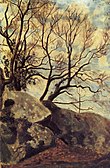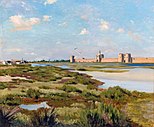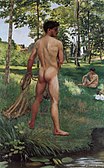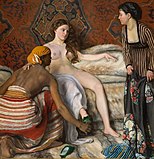Frédéric Bazille
French painter (1841–1870) From Wikipedia, the free encyclopedia
Jean Frédéric Bazille (French pronunciation: [ʒɑ̃ fʁedeʁik bazij]; December 6, 1841 – November 28, 1870) was a French Impressionist painter. Many of Bazille's major works are examples of figure painting in which he placed the subject figure within a landscape painted en plein air.[1]
Frédéric Bazille | |
|---|---|
 Self-portrait, 1865–1866, oil on canvas, Art Institute of Chicago | |
| Born | Jean Frédéric Bazille 6 December 1841 |
| Died | 28 November 1870 (aged 28) Beaune-la-Rolande, France |
| Known for | Painting |
| Movement | Impressionism |
| Signature | |
 | |
Life and work
Summarize
Perspective

Frédéric Bazille was born in Montpellier, Hérault, Languedoc-Roussillon, France, into a wealthy wine merchant Protestant family. Bazille grew up in the Le Domaine de Méric, a wine-producing estate in Castelnau-le-Lez, near Montpellier, owned by his family.[3] He became interested in painting after seeing some works of Eugène Delacroix. His family agreed to let him study painting, but only if he also studied medicine.[1]
Bazille began studying medicine in 1859, and moved to Paris in 1862 to continue his studies. There he met Pierre-Auguste Renoir and Alfred Sisley, was drawn to Impressionist painting, and began taking classes in Charles Gleyre's studio. After failing his medical exam in 1864, he began painting full-time. His close friends included Claude Monet, Alfred Sisley and Édouard Manet. Bazille was generous with his wealth and helped support his less fortunate associates by giving them space in his studio and materials to use.[1]
Bazille was just twenty-three years old when he painted several of his best-known works, including The Pink Dress (c. 1864, Musée d'Orsay, Paris). This painting combines a portrait-like depiction of Bazille's cousin, Thérèse des Hours, who is seen from behind—and the sunlit landscape at which she gazes.[4] His best-known painting is Family Reunion, painted 1867–1868 (Musée d'Orsay, Paris).
Frédéric Bazille joined a Zouave regiment in August 1870, a month after the outbreak of the Franco-Prussian War. On November 28th of that year he was with his unit at the Battle of Beaune-la-Rolande when his commanding officer was injured. That required him to take command and lead an assault on the German position. He was hit twice in the failed attack and died on the battlefield at the age of twenty-eight. His father travelled to the battlefield a few days later to take his body back for burial at Montpellier in the Protestant cemetery over a week later.[5][6]
Personal life
Bazille never married, claiming it was because of “an early heartbreak with a woman.” He developed intimate friendships with men, such as Edmond Maître, but was also melancholic and claimed to “hav[e] constant migraines while he was painting his nude men.” This and the homoeroticism of his paintings led to modern suggestions that Bazille may have been gay and conflicted about his sexuality.[7][8]
Main works
- La robe rose, (1864) – 147 x 110 cm, Musée d'Orsay, Paris
- Studio on Rue Furstenberg, (1865) – 80 x 65 cm, Musée Fabre, Montpellier
- Aigues-Mortes, (1867) – 46 x 55 cm, Musée Fabre, Montpellier
- Self-portrait, (1865) – 109 x72 cm, Art Institute of Chicago
- Family Reunion, (1867) – 152 x 230 cm, Musée d'Orsay, Paris
- Le Pécheur à l'épervier, (1868) – 134 x 83 cm, Fondation Rau pour le tiers-monde, Zürich
- View of the Village, (1868) – 130 x 89 cm, Musée Fabre, Montpellier
- Scène d'été, (1869) – 158 x 158 cm, Cambridge, Harvard University
- La Toilette, (1870) – 132 x 127 cm., Musée Fabre, Montpellier
- L'Atelier de la rue Condamine, (1870) – 98 x 128.5 cm, Musée d'Orsay, Paris
- Paysage au bord du Lez, (1870) – 137.8 x 202.5 cm, The Minneapolis Institute of Arts, Minneapolis
Gallery

- Self Portrait, unknown date
- Study of Trees, 1863
- Reclining Nude, 1864
- The Pink Dress (View of Castelnau-le-Lez, Hérault), 1864, oil on canvas, Musée d'Orsay
- Chailly, 1865, Musée Fabre, Montpellier
- Studio on Rue Furstenberg, 1865, Musée Fabre, Montpellier
- Little Italian Street Singer, 1866
- Le Petit Jardinier (The Little Gardener), c. 1866–67, oil on canvas Museum of Fine Arts, Houston
- Nature morte avec du poisson, Still life with fish, c. 1866–67
- Portrait of Renoir, 1867, oil on canvas, Musée d'Orsay
- Aigues-Mortes, 1867
- The Family Reunion, c. 1867, Musée d'Orsay
- Nature morte au héron, 1867
- Etude pour une vendange, 1868
- View of the Village, 1868, Musée Fabre, Montpellier
- Fisherman with a Net, 1868
- Portrait of Alphonse Tissie, 1868, Musée Fabre, Montpellier
- Flowers, 1868
- Portrait of Paul Verlaine, 1868, Dallas Museum of Art
- Portrait of Edmond Maître, 1869
- La Toilette, 1870, Musée Fabre
- Paysage au bord du Lez, 1870, oil on canvas, Minneapolis Institute of Arts
See also
Notes
References
External links
Wikiwand - on
Seamless Wikipedia browsing. On steroids.
























